Your Planets
Portraits of the Planets
Aspects between Planets
The planetary ages
The planetary families
Planets in Signs
The Planets in comics


The balance sheet of conditionalist astrology presented here was written in 1980. Conditionalist theories, practices and methods having progressed a lot since then, this balance sheet cannot be exhaustive. It nevertheless presents and recapitulates all the fundamental elements of this natural and rational approach to astrology.
The real: manifested, potential or virtual, known or unknown. The real of man, of his internal and external environment, social, family, geosolar, metaphysical too. The reality of the relationships and interactions between man and ideas, ideas and symbols, symbols and facts. The means of approaching reality.
The cycle of variation of the duration of presence (diurnal arc) of a star above the plane of the horizon. This cycle being both a function of the geographical latitude of the observer and of the declination of the observed star, it is necessary to design zodiacs relating to places and a universal zodiac, the effects — possible — of their interference appearing among the questions treat.
Fig. 1 : zodiaque universel des déclinaisons. La sinusoïde bleu fonçé représente l’écliptique (trajectoire géocentrique du Soleil), le ruban bleu clair la bande zodiacale (9° de part et d’autre de l’écliptique) à l’intérieur de laquelle se meuvent la Lune et les planètes jusqu’à Neptune compris, Pluton étant un cas particulier.
Fig. 2 : zodiaque universel des déclinaisons et zodiaque photopériodique (diurne-nocturne) pour la latitude terrestre de 45° Nord. Pour chaque Signe, les hémisphères blanc et noir représentent respectivement les durées diurnes et nocturnes pour cette latitude terrestre pour le Soleil ou pour un astre sans latitude écliptique.
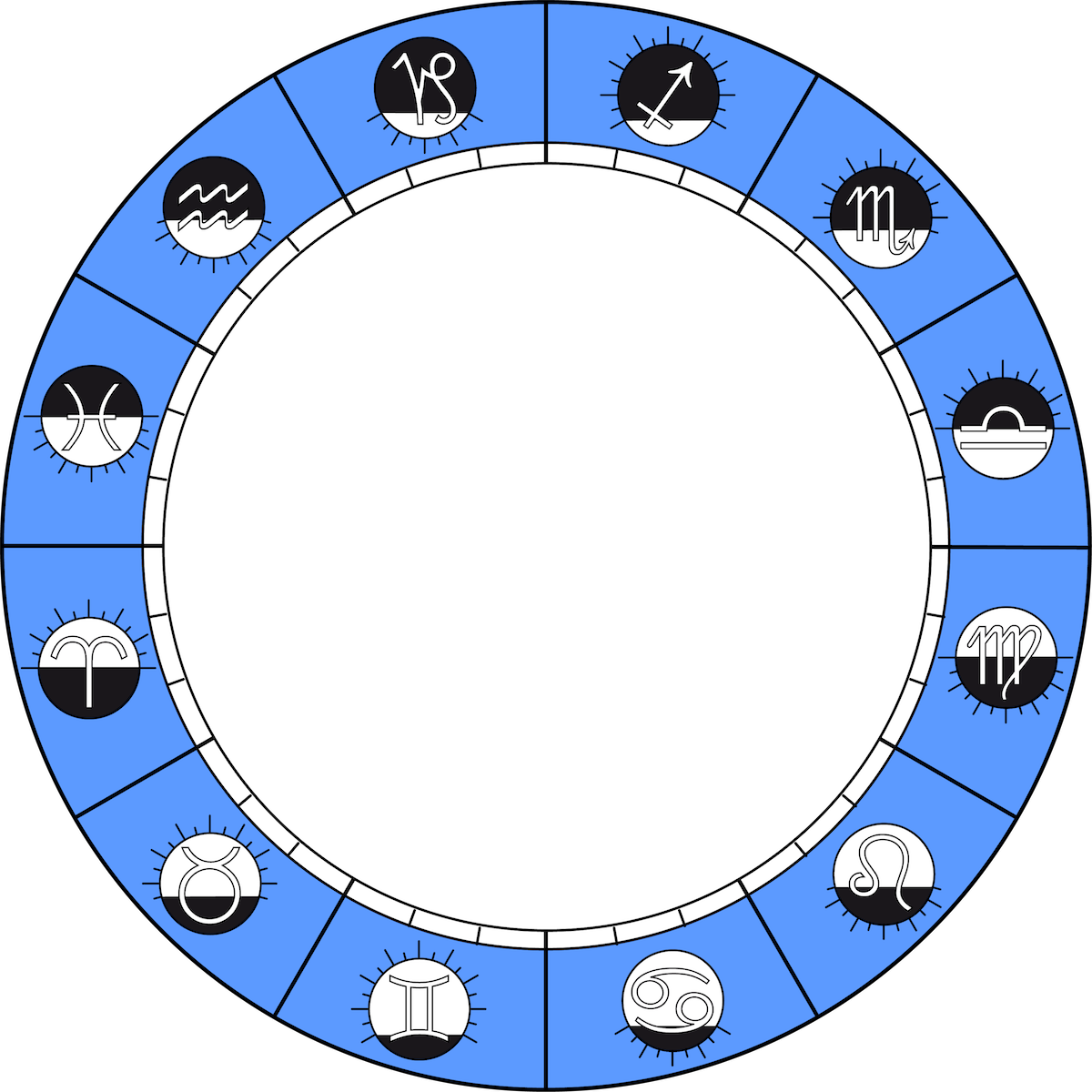
Fig. 3 : représentation circulaire du zodiaque photopériodique (diurne-nocturne) pour la latitude terrestre de 45° Nord. Pour chaque Signe, les rayons représentent la croissance de l’arc diurne ou nocturne, leur absence la décroissance, toujours pour cette latitude terrestre et pour un astre sans latitude écliptique.
This zodiac is real, immaterial but not imaginary. Its foundations involve the terrestrial rotation and the inclination of the ecliptic plane with respect to the plane of the celestial equator. Moreover, the conditionalist zodiac refers to light as a signal of the source rather than as a force of action or explanatory of an effect, the problem of the nature of the planetary influence not being posed at this level.
This zodiac, non-seasonal, purely external to the Subject, is denoted by “photoperiodic zodiac”. The diurnal arc being distinct from the day-light (particular case of the diurnal arc of the Sun), the Sign takes on a reality that owes nothing to the Sun and to meteorological afterglow erected into symbolist principles. A zodiacal fourth, an extension of 30°, of 1° or the smallest imaginable arc can be represented by precise and comparative quantities, abstract but measurable, such as the durations of presence (diurnal arcs), the functions of increase of these durations or the ratios of the durations of arcs, so many means of giving oneself objective bases for comparative analyzes.
The expression of a Sign by a numerical ratio (frequency of presence, increasing or decreasing) allows a homogeneous mathematical representation of the Sign-planet combination, each star, due to the duration of its cycle (sidereal revolution), also being defined by a frequency.
The connection of the photoperiodic zodiac with the human receptor leads to a systematic of the most frequent effects expressed in neuro-physiological formulas. This “Subject” or reflexological zodiac can be considered as the cycle of variation of nerve activity (ideal cycle) defined by its excitation and inhibition processes, their relationships, their respective intensity and mobility.

Just as the photoperiodic, the reflexological zodiac has its own reality, independent of the first, even if the genesis of man often makes him the passive heir of the rhythms and cycles of the environment. Inheritance constitutes an acquisition capable of great autonomy, so that exogenous temporal structures, after having been normative, act on endogenous temporal structures as triggers, without having entirely lost their formative power. In other words: the species has integrated the planetary clocks and these, privileged instigators of the internal clocks, nevertheless retain an active-training role that the practitioner tests during the exercises transits (this is why transits do not bring solutions, but problems, the solutions varying with the power of response and adaptation species and individual).
The relationship between heaven and man is not an absolute continuum. it is discontinuous, relative and is expressed by variable frequencies according to the basic sensitivity and the states of receptivity created by age, the various degrees and levels of emotional, mental, biological excitability. The signal planets act as level inducers which, in turn, act as selectors of influences. The conditionalist language, if it is not always simple, makes it possible to pose the problems in a natural frame of reference.
Horoscope “subject reflection” is a scam that must disappear from the vocabulary of the honest man. Beyond the Arctic and Antarctic polar circles, one can be born without a horoscope without dying or losing one’s status as a subject. With the north of Canada, Siberia, Norway, Scandinavia, how many living beings are there not subjects for lack of a horoscope? And what becomes astro-statistics in these terrestrial places with permanent angularities or non-angularities?
The reflexological formulas are established in accordance with the known laws of nervous activity. If Pavlov largely contributed to the discovery of these laws, it is not being a Marxist-Leninist, pro-Soviet Stalinist to use these discoveries by protesting against the scandalous interpretation of Pavlov’s work in the West. A scientist like P. Chauchard, who cannot be suspected of materialism, was indignant. There gravitation does not belong to those who formulated its principles, and it is not being Newtonian to fall from a 6th floor following the protocol of attraction of the masses.
The distinction between external (photoperiodic) zodiac and internal (reflexological) zodiac goes back to the publication of La Condition Solaire in 1965, but the reference to the external environment was used against the conditionalists, slanderously taxed with mechanistic and deterministic materialism whereas the conditionalist thinking is the only one to restore the values of consciousness, will, free will by refusing to link them to the movements of the stars (it is true that for our magicians, these movements are symbols).
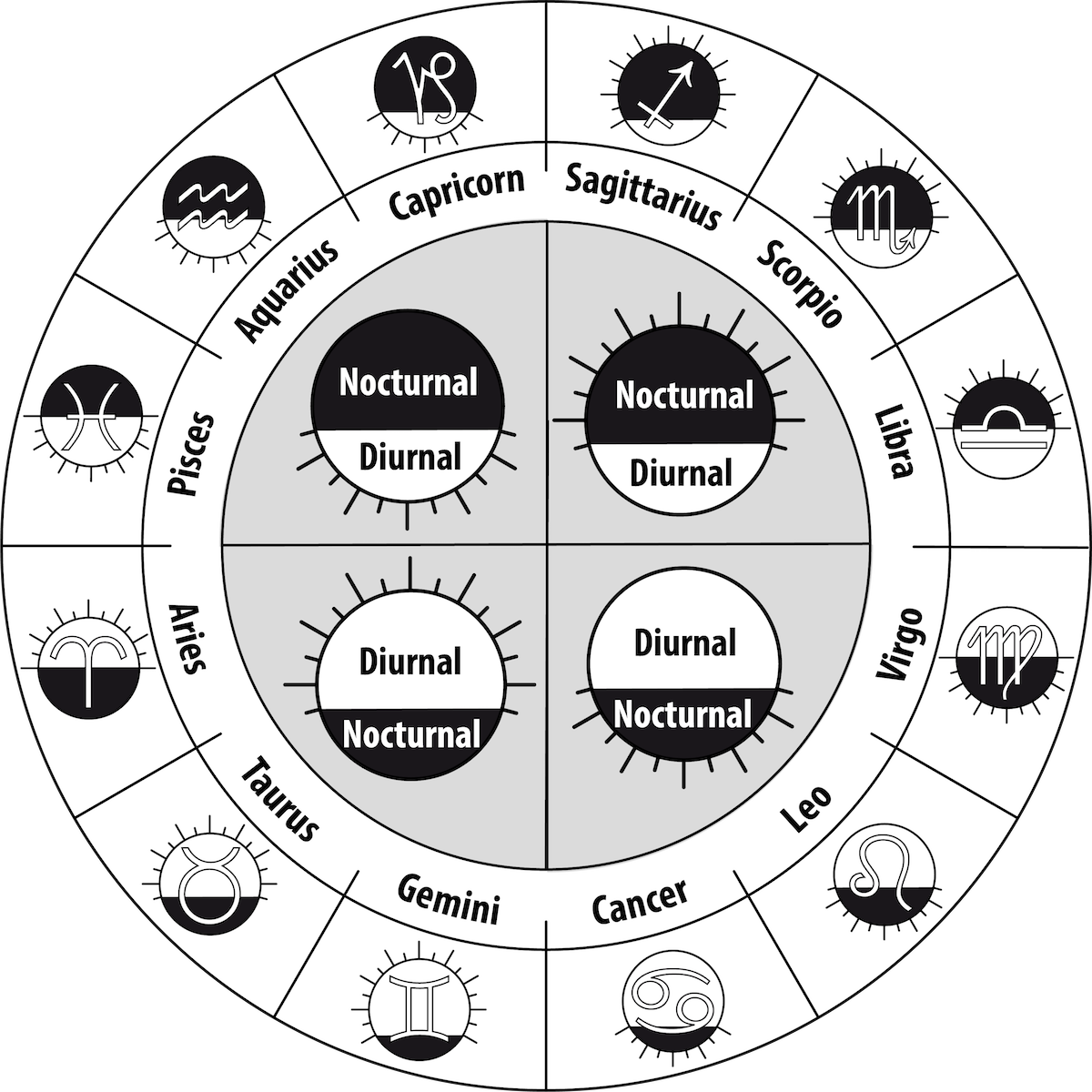
They are theoretical and practical. The formulas allow the elaboration of theoretical portraits, as they allow, for research purposes, to express the zodiacal components of a chart in a synthetic language facilitating comparative studies, rankings and communications between researchers.
On a theoretical level, the applications of the formulas simplify the typological correlations ordering them. It is possible, from the elements of a formula neurophysiological to understand the part concerned by an astro-psychological correlation. The method reveals the fragmentary nature of a typology in relation to the globality of the Sign, better grasped by reflexological definitions.
Practical applications relate to written and oral interpretations. The formulas, abstract in themselves, call for two different languages. They are transposed into concrete images, metaphors, or concepts, depending on the comprehension plan adopted for the interlocutor.
Personal practice and group practice, the latter becoming possible with rigorous codification, a common dictionary of analysis. The “vague” is not prohibited. It is dosed, at will. The conditionalist interpreter knows when, by intuition or empiricism, he goes beyond what the definitions normally allow him to say.
The control also passes through biographical studies, analyzed, always, by means of strict formulas. The exchanges of appreciations between conditionalist interpreters cannot turn into a power struggle, the impersonal language not calling into question the superiority of one flair over another. The possibilities of understanding and acquiring this language are also related to the psycho-mental dispositions, the will to personal power, the attraction for the “master” appearing among the most harmful to intellectual receptivity, as much as the magician faith that disturbs any rational explanation.
The progress made in conditionalist astrology results from the communications allowed between researchers and practitioners having a language at the height of the complexity of their work. The other schools — apart from astro-statistics which cannot be invented — recognize that there can be, at the limit, as many astrologies as astrologers. The conditionalist is only one among many others, the product of an author… this one or another. To be a conditionalist amounts, for these brilliant psychologists, to giving themselves a “chief”. Ptolemy, Cardan, Kepler, and their ideal of objectivity is far from all that… Vote for me (5).
The most important seems to me to be that of a experimental astrology. The frequencies specific to the Signs can be reproduced with signals other than light and can be studied on various species (plant cultures, microbial). A dominant “Aries” can be crafted like any other zodiacal frequency. The effects can then be compared, at various levels and according to various criteria.
There are already works (experimental neuroses) which, in complete ignorance of astrology natural, confirmed both the effects “negatives” egalitarian phases — this for Pavlovism — than the astro-conditionalist portraits attributed to these phases — this for the reflexological and photoperiodic zodiacs.
In his prospective conducted at the theoretical level, the astro-conditionalist highlighted the importance of the numerical ratio 1–2 in the planetary aspects, the distribution of planetary distances, and the subdivision of the fourths into three sectors for the zodiac of the declinations. This ratio, a unit constant of different frames of reference, concerns for humans the laws of neuronic transmission. However, this number refers us to axial symmetry, to the right and left of the brain, to the rotary power of light, to spins… A royal road to find, in short, the common frame of reference for all frames of reference.
As you can tell, conditionalist astrology is just one theory among many.
The real… and the means of approach.
The duration of the cycles of the sidereal revolutions, duration expressible by frequencies.
This heliocentric reference has given rise to strong criticism: astrology being — metaphysically or physically? — geocentric, it seems illegitimate to justify it by cycles relating to the Sun. In fact, heliocentric cycles give simple, non-compound frequencies. Geocentric cycles (synodic revolutions) are obtained by addition or subtraction between the terrestrial frequency and that of a planet. It follows that the time-interval between two superior observable conjunctions (geocentrism) is expressed for Mercury and Venus by: 1/S = 1/T − 1/A, equation in which:
▶ S = synodic revolution
▶ A = sidereal revolution of the Earth
▶ T = sidereal revolution of the planet.

For example, for Mercury, adopting the mean day and the Julian year:
▶ A = 365.25 jm 1/A = 0.0027378
▶ T = 88.00 jm 1/T = 0.0113636
From which we get: 1/S = 0.0113636 − 0.0027378 = 0.0086258
And, finally: S = 115.93 jm, synodic (mean) revolution of Mercury or time interval elapsed between two superior conjunctions Sun-Mercury.
From Mars, the formula is written: 1/S = 1/A − 1/T. As with Mercury and Venus, it operates on frequencies.
The assertion of incompatibility between an astrological geocentrism and an astronomical heliocentrism is part of the gross nonsense propagated by “metaphysicians” who do not hear a treacherous word about what they claim to go beyond (meta: beyond). Did they wonder whether the planetary aspects were frequencies, harmonics of a period, or spatial divisions resulting in characteristic incidences? The author of the distressing “cyclical index”, virtuoso in amalgams, simply does not understand the difference between space and duration, so he adds arcs traveled to arcs not traveled, as if to calculate the average age of a family, we add the expectation of life of a centenarian to the first days of a newborn. But the most incredible thing is still to find supporters and publishers with such drivel.
With the spirit of a Ptolemy, but using, this time, the knowledge of our time, the conditionalists apply the sidereal cycles to psychogenetics. There Theory of Ages refers to this application which simply consists in observing what mental, psychological, physiological, relational acquisitions occur in a normal evolution of man in the succession of time intervals given by the durations of sidereal revolutions taken in ascending order.
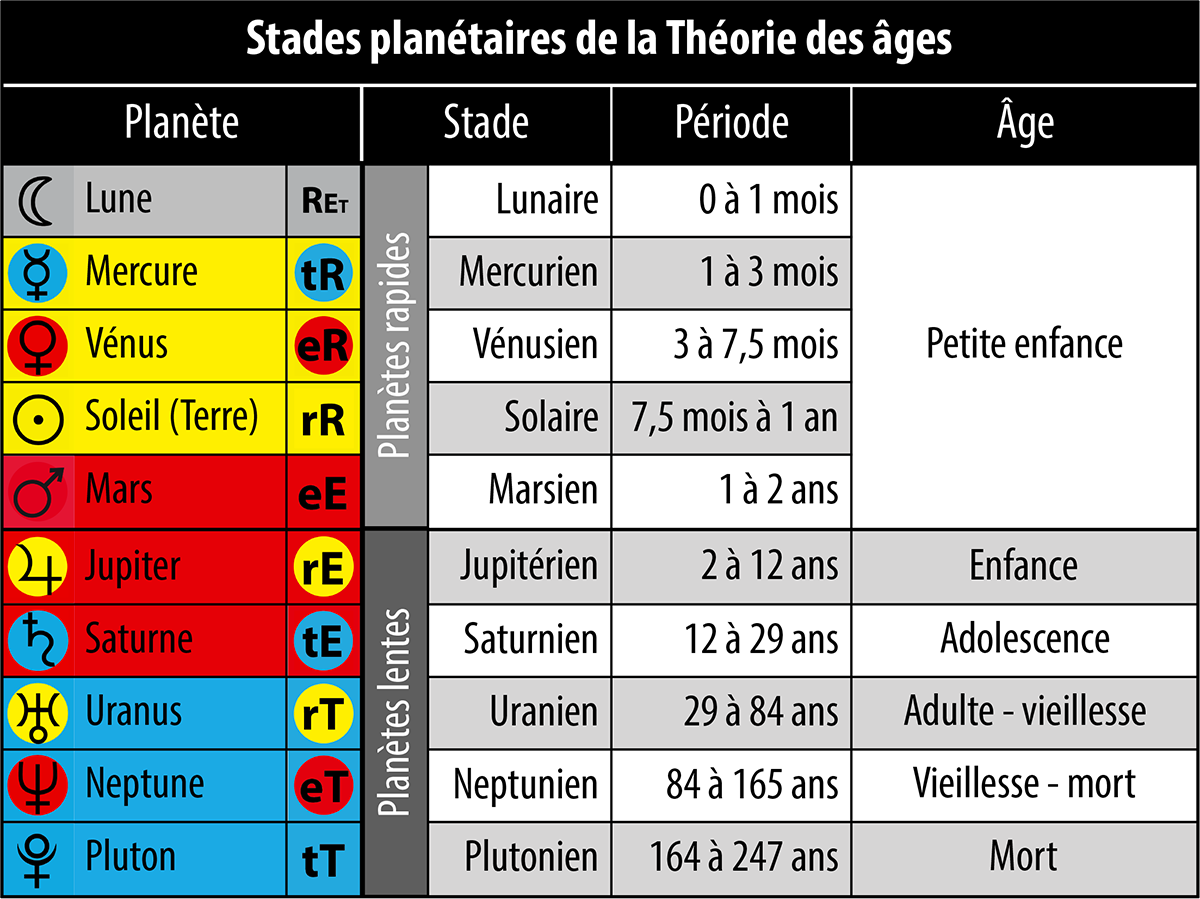
Far from the mythical gods, the planetary meanings are studied on the spot, in the apprenticeships and acquisitions of each age of life, placed in parallel with the strongest cycle at the age concerned. The other cycles, in a sequence determined by the interval of two planets, are not eliminated. They are taken into account according to the importance of the planetary aspect — and more precisely according to the harmonic — involved. Thus, the sidereal revolution of Jupiter being 12 years, that of Saturn approximately 29.5 years: the time interval of 12 to 29.5 years is placed under a saturnian dominance, not exclusive of other components, such as, for example, the passage, for the planet Uranus which comes after Saturn, from the first sextile (around age 14) to the first square (around age 21), these aspects being able to be indicated by harmonics of the periods or integer multiples of the frequencies involved. With two of the slow planets, the conditionalist understands the 14 to 21 phase as Saturn’s strong time modulated by a uranian harmonic (sextile squared). A native aspect Saturn-Uranus is not an angle frozen in a static absolute, it immediately designates adolescence as a significant formative stage.
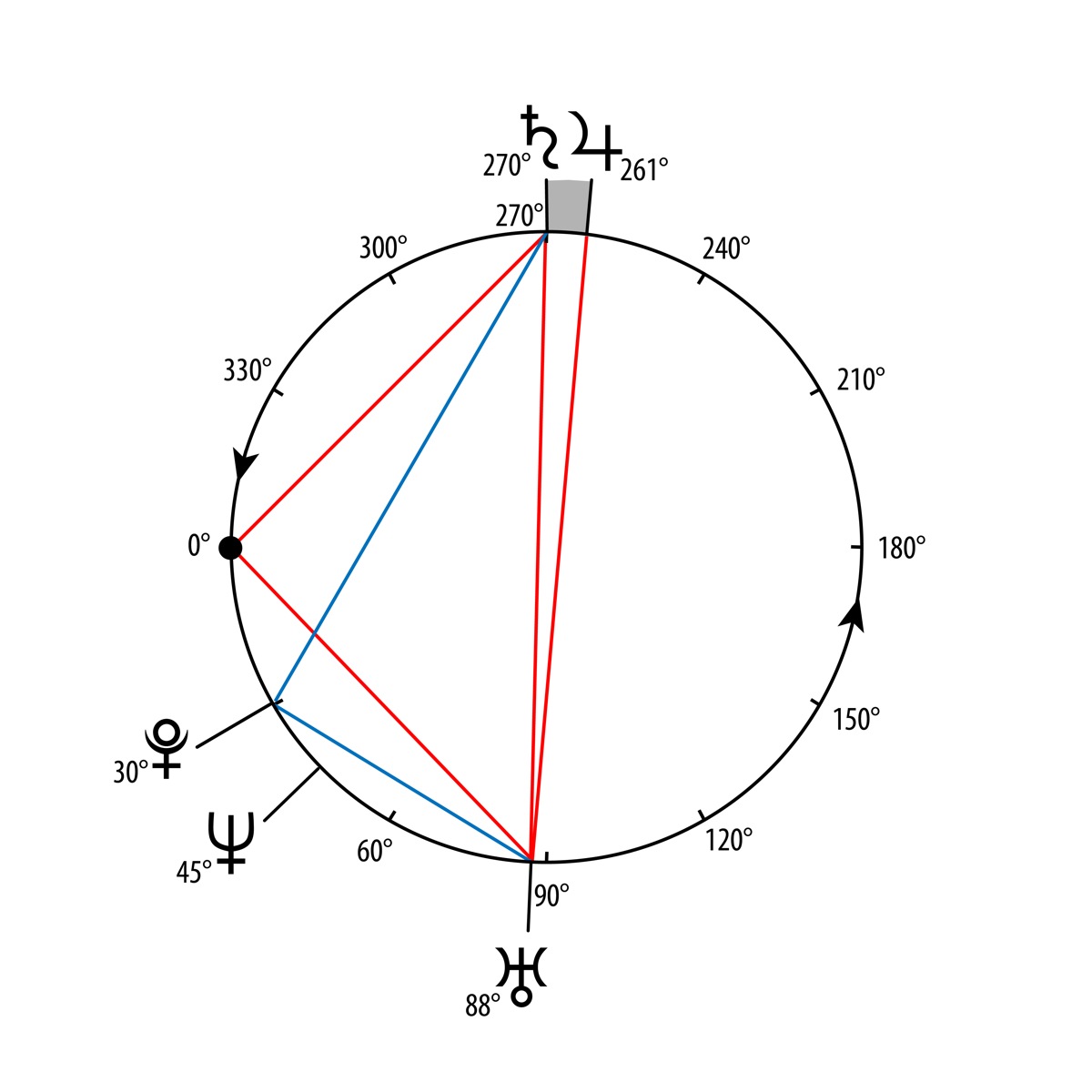
Fig. 4 : Thème d’âge pour 21 ans. Pour construire un Thème d’âge, on trace un cercle marqué d’un point 0° sur la circonférence. On considère que ce point 0° est l’origine, le point de départ de tous les cycles planétaires. Ensuite, pour chaque âge que l’on désire étudier, on mesure l’élongation (le nombre de degrés de longitude écliptique parcourus en un intervalle de temps donné), moyenne ou réelle, des planètes à partir du point 0°.
By generalizing, we conceive a age chart: universal chart giving for each age of life the (average) internal elongations of the slow planets. This chart can have various and, above all, forward-looking applications. It allows an explanation of the transits.
The theory of ages is not limited to recording the work of psychogeneticists (Piaget, Wallon, Spitz), it sheds light on them. His contribution can rightly be considered capital in terms of the human and biological sciences and in terms of the philosophy of these sciences.
With the theory of ages, human time, the meaning of durations, are analyzed differently than by simple chronological sequence. Just as white light is decomposed by means of a prism, the age chart indicates the internal organization of the components of a moment or age of life. We go from a primary temporal dimension to a representation of rhythmic structures: the “time” is formalized in geometric patterns that have nothing to do with spatial symbolism.
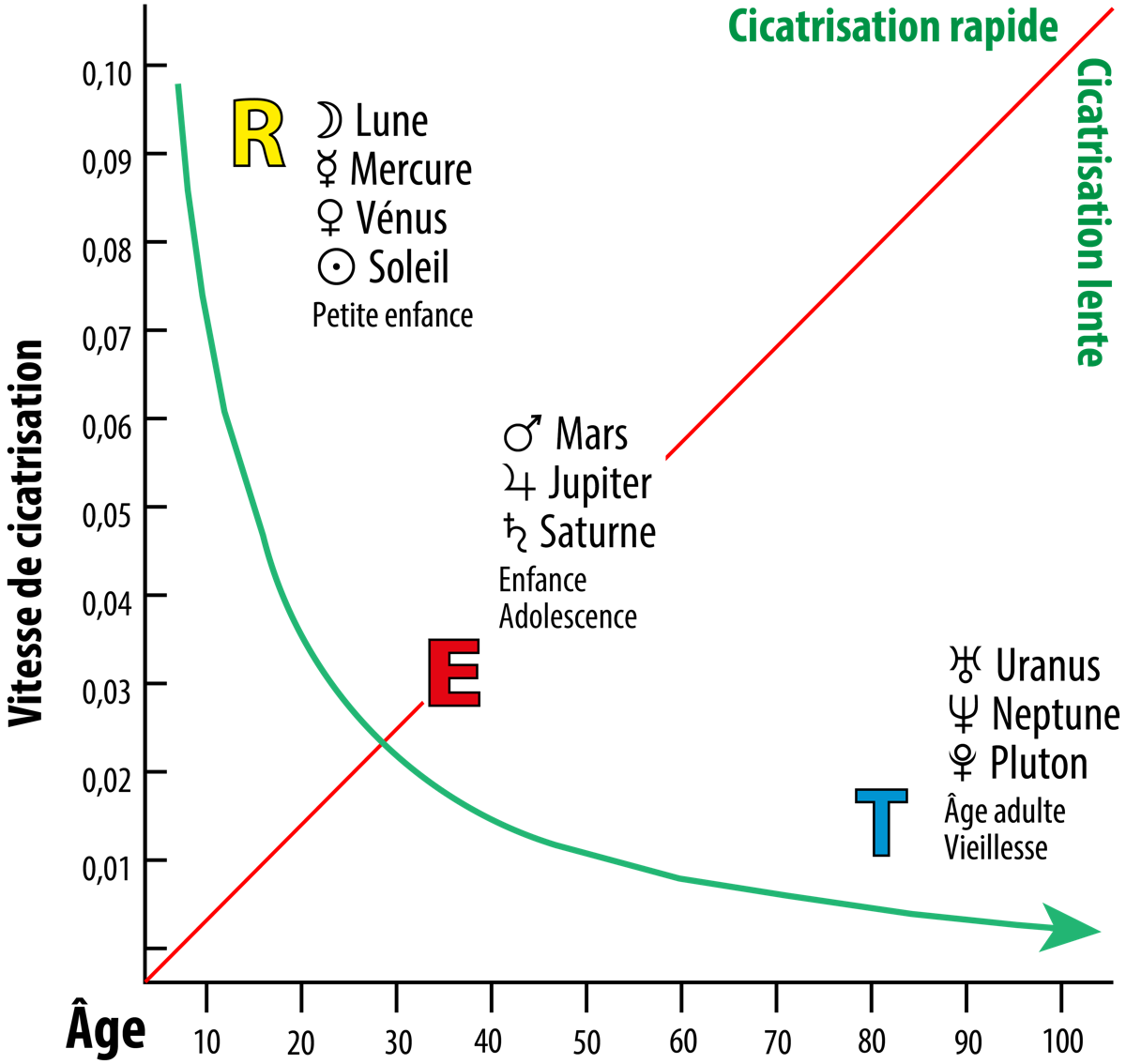
Fig. 5 : la durée croissante des cycles planétaires, les âges de la vie et la vitesse de cicatrisation sont sur un même segment de branche d’hyperbole.
For example: the rate of healing (Lecomte du Noüy) testifying to a biological time is formally represented by a segment of a hyperbola branch. The figure lends itself to symbolist extrapolations but it can do without. Inasmuch as “abstract signal”, it gives the snapshot of the past-present-future of a physiological receptor, with a destiny all traced with regard to healing. Certain properties of the curve can, with caution and rigor, point to properties of the time of life which do not appear in the purely chronological study of vital processes.
The same geometric representation is obtained with the linear velocities of the bodies subjected to a central force and their distances from this attractive center, the product of the speed by the root of the distance giving a constant. Another hyperbola branch segment appears in the distribution of planetary semi-major axes (6).
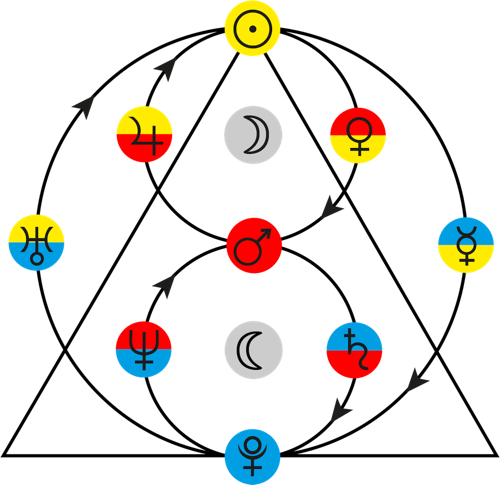
Fig. 6 : représentation circulaire des planètes et des 3 niveaux du R.E.T. (Soleil en haut, Mars au centre et Pluton en bas).
The three levels of R.E.T. have been deduced from these structural correlations between living time and astrometric time, that of man and that of the solar field involving the same hyperbolic representation. The central area of the healing rate curve called the plane ‘E’ (predominance of Existence values in our most active ages). Lecomte du Noüy did not hesitate to understand his results in this way: “Between infinite speed and infinite slowness, exactly midway, straddling the axis of the hyperbola—which intersects the curve at the point corresponding to thirty-one and a half years—is the zone of maximum curvature, that of our material and conscious existence” (time and life). After the central curvature, the segment of the long durations called the ‘T’ (the unknown, Transcendence as beyond the ages of individual life). It remained to signify the ‘R’ to segment symmetrical: the first ages, those of the symbols, of the language, of the formative models of the Ego imposed themselves.

Fig. 7 : dans le R.E.T. chaque fonction planétaire se caractérise par son niveau-source (majuscules R, E, T) et par son niveau-but (minuscules r, e, t). Les couleurs sont symboliques : jaune pour la Représentation (clarté, lumière), rouge pour l’Existence (passion, vitalité) et bleu fonçé pour la Transcendance (profondeur, obscurité).
From its conception, the R.E.T. was dedicated to speeds: the ‘R’ to the short term, to initial reactions, to the changing or absolute instant, the ‘E’ to the medium term and the ‘T’ to distant deadlines as well as to long memories. It remained to combine the memories or imagine, in another frame of reference, constant speeds, slowed down or accelerated, these modifications becoming inciting signals that man, with his memories, symbolizes or conceptualizes by following the hyperbole of life. Curious as it may seem, the R.E.T. is a logical application of the healing rate curve. For a scientist, of course, these are only abusive extrapolations.

Fig. 8 : formules développées des fonctions planétaires du R.E.T..
The reference to energy levels, or the hypothesis of a quantification of planetary orbits analogous to that of atomic orbits, followed naturally from the R.E.T. In absolute terms, all frequencies being possible, the energy level introduces selection rules giving a privilege of effects. In other words: it is not enough to turn in the sky to be part of the cycles sensitive to biological clocks. Our pendulums, external and internal, must have, in order to correspond, a common ground or resonance. The balance sheet of Numbers and Forms of the Cosmos designates hydrogen, a simple atom, a universal constituent of inert and animate matter. The most characteristic frequencies of this atom lead to the distribution of the semi-major axes of the main planets of the solar system. The bridge has been thrown… Since the publication of For a modern astrology (7), this research has further progressed and the occultation practices of conditionalist astrology thus drift, over the years, from baseness to ridicule.
The conditionalist references largely encroach on the prospective, because of the dynamics of this school. Before coming back to this, let’s open the parenthesis of current applications.
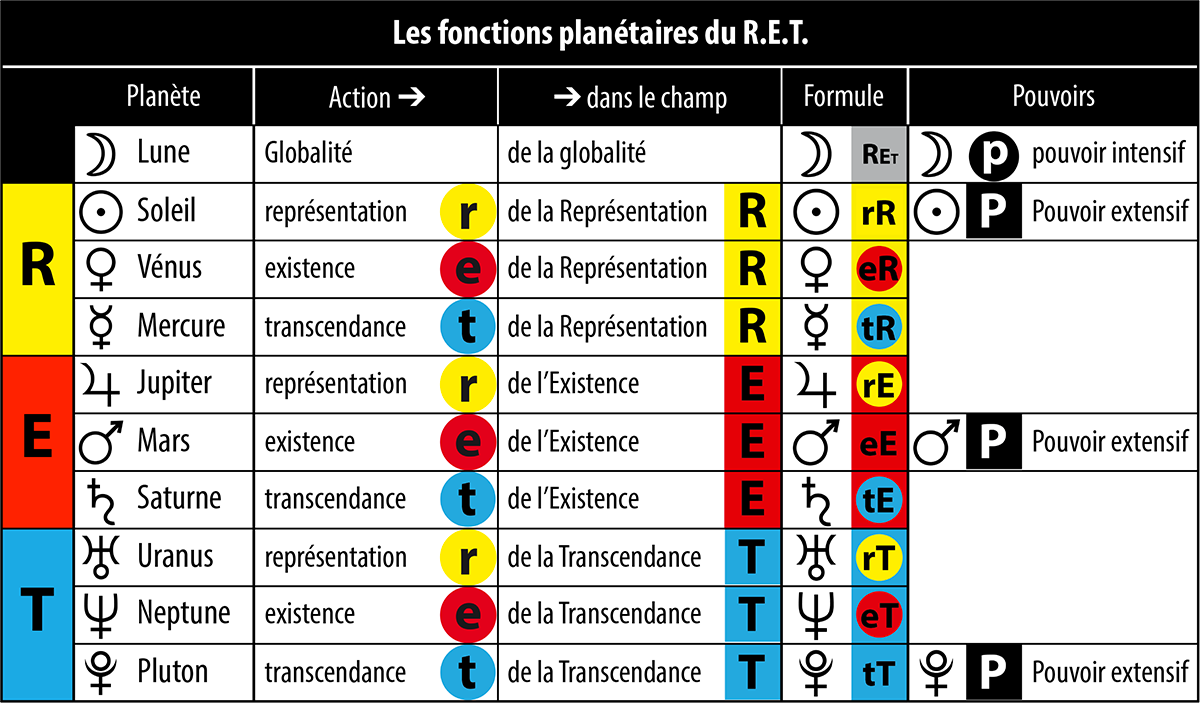
Theoretical applications allow, by the R.E.T., to imagine, to understand and to dismantle the cogs of as many philosophies as we want to give ourselves. The structure of the R.E.T. adapted to the workings of the mind constitutes a tool of choice for comparing or combining apparently indifferent frames of reference, frozen in their singularities by Cartesian categories. In this respect, the symbolism, having no system, limits itself to deconstructing all the frames of reference to amalgamate them into a symbol that is both unspeakable and strong in overdeterminations. In this, the symbol can say everything, say nothing and say anything.
As with the zodiac, theory leads to prediction and the development of controllable and amendable portraits through practice. The reference frame of excitability common to the planets and the Signs allows a rational conception of the planetary effect in Sign, the star manifesting in the Sign its function of maintaining, rising or falling in level. In interpretation, the formulas make it necessary to seek original syntheses expressing the problem of the chart and that of each aspect. There is no longer any question of intertwined signatures, of a Me dressed as a Harlequin. It is a human reality, and its globality in search of balance like the solar system, that the interpreter seeks to grasp by cross-checking the structural information provided by the chart with the extra-horoscopic information that he recognizes as such.
A conditionalist practice requires a lot of mastery, patience, loyalty. There is no recipe possible: no search for spectacle or manipulation. To be difficult, the diagnosis is often safer and more useful to the consultant!
Personal and collective practice, biographical studies. The theory of ages also makes it possible to compare planetary meanings with the work of psychogeneticists. The homogeneity of the system R.E.T. only admits admissible correlations both in the physical frame of reference and in the neuro-psychological frame of reference. A logical correspondence is not enough, this logic must also be that of the living. Moreover, each established meaning must prove itself by generalization. For example, one cannot attribute the liver to Jupiter because it is the most massive of the planetary bodies, if one does not use, for the other planets, the same criterion of masses. Homogeneity does not allow, either, to place separation from the maternal breast (weaning) at the dawn of death or sado-oral teething after military service. Uniformity, selective and severe, is an intractable but irreplaceable guide in research. This criterion quickly eliminates imperfect or erroneous explanations.
Other experimental controls depend on the results of the prospective. It is obvious that if we manage to locate the physical supports of the planetary influences, precise experiments on the value of the hypotheses put forward can follow.
A vast field of discoveries is offered to a new instrument of analysis and synthesis. The R.E.T. is comparable to a “macroscope” (8) well suited to reveal, in the fields where it applies and between these fields, relations other than causality. As a common matrix to the Object (transmitter), at Subject (receiver), to their Relationships (interactions) and their Integrations, it unifies our fields of conceptions, brings new explanations, promotes the convergence of rational and imaginative faculties. You still have to have the audacity to use it…
| Subject | Object | Relationship | Integration |

| Excitability | Signal | Communication | Symbol |
| High level Medium level Low level |
Simple Compound Complex |
Representation Existence Transcendence |
Unique Duel Multiple |
| Energy | Space | Time | Structure |
Let us take, for demonstration, a small example of application of the R.E.T. and repositories Subject (S), Object (O), Relationship (R), Integration (I). For the conditionalist, the sky and the man are distinct, what is above is not below, there is a Subject and an Object: if the sky is “subject”, Man is “object”, if the man is caught in “subject”, the sky is “object”. The relationship is that of a couple with its agreements and disagreements, its movement and its continuity. The nature of this bio-cosmic couple prohibits a mechanical relationship with rigid fatalism. But, when the relationship is in a homogeneous phase, the resulting integration makes it possible to have a single repository and a single reading for the subject, the object and their relationships. We will say that man has become his sky or that there is no difference between what he could do with it and what he did with it. This phenomenon of integral relationship is observed in the beings who mark history and seem tailor-made for a milieu and an era.
Mystical trance is not essential to understand these things. It is the intermediaries, permutations between levels and functions of different frames of reference, which give the R.E.T. its prospective power.
With the Theory of Ages, the R.E.T. has already made it possible to understand the meaning of certain stages of nerve maturation, to go further in understanding than psychogeneticists. Astrometrically, the R.E.T. has made it possible to update periods internal to the solar system, planetary periods of the order of magnitude of 3 to 270 days like those of stars called “pulsating” (Cepheids).
At the level of the neurophysiological receptor, in addition to the three memories which have respective centers (9), the R.E.T. recalls the left-right structure of the brain, the model of planetary organization coupling a star with a cycle lower than the solar cycle (11.2 years on average) to a planet with a higher cycle. The left-right coupling therefore exists both in humans (structure and functions of the brain) and in the sky (frequencies or cycles). It recalls the duo-duel of nature and culture, individual and species, symbol and signal, all distinct functions with dynamic interactions. An open perspective, therefore, on the understanding of brain functioning.
Socio-political prospective with the problem of the balance of functions and powers defined by the three levels of the R.E.T. and their interactions. The theory of ages poses the problem of the hierarchy of values, the R.E.T. that of their balance.
Prospective open to the “shrink” with changing designs over time. The theory of ages testifies to a certain chronological unfolding by succession of different hierarchies. The R.E.T. testifies to the existence of a relative plane of simultaneity. For the trilogy: past-present-future, it is necessary to substitute: diachronism-synchronism or in terms of popularization: chronological development and simultaneous effects, knowing that the chronological integrates causal relationships and the simultaneous statistical series or complex causalities, not apparent. In a homogeneous phase, we designed a subject-object identification allowing the understanding of one by the other, subjective and objective then falling under a common frame of reference. Homogeneity makes possible the identification of the chronological with the simultaneous: the effects to come can then be “deduct” of phenomena without a causal relationship. Or, another formulation: concomitant manifestations induce a program of development. Conversely: a development plan (objectives, goals, projects) induces another present of the world.
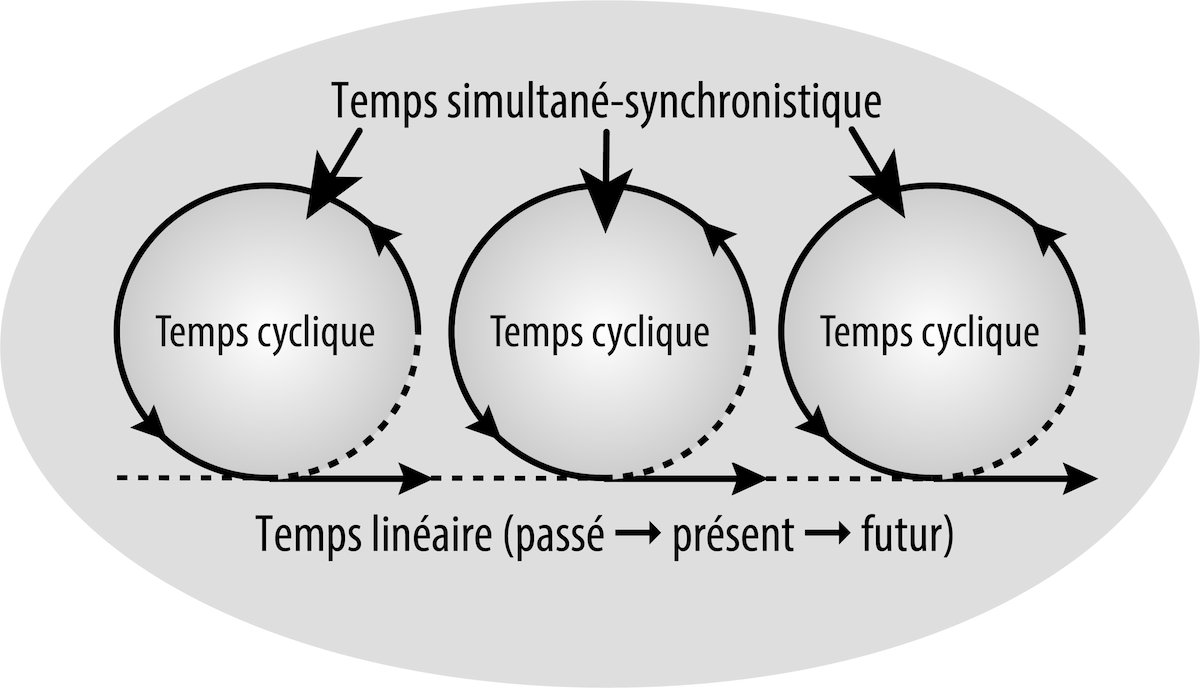
Fig. 9 : représentation de l’imbrication des temps cycliques et linéaire : la cyclicité n’est pas contradictoire avec la linéarité.
These ideas are far from fiction. They say, clearly, that from the simultaneous appearance of phenomena with no apparent relationship but belonging to the same set, it seems possible at a given moment to apprehend the development of one of the parts of this set.
It turns out that the “topics” gifted for clairvoyance appear to derive from a Moon function (devolved on homogeneity) combined with a long-term planet (Uranus, Neptune, Pluto) or Mars, reduced to aggressiveness by wild psychoanalysis, while the conditionalists recognize in it a function grip on reality.
The prospective of the R.E.T. also engaged in atomistics with the hypothesis of energy levels for planetary orbits and the obvious role that integers play in the distribution of these orbits.
These are some of the prospective paths of the R.E.T., of which a leader of Bile of contemporary astrology has dared to write: “I allow me to say that, for the moment, astro-reflexology, as it is at its present stage, is only a typology ; and it is not – by far – the richest! The typology being defined as a classification by categories, the R.E.T. For example! typically”, specifying that: “If you can hope to provide details and certainties that are currently lacking, you cannot embrace the human synthetically as I do at my level.” Not having the habit of playing ambiguity, the complete file will be published, to put an end to these embarrassing controversies, etc.
See above for the principle. The reality of Houses or sectors of the local sphere is undefined. Are they portions of space, portions of time (durations), spatial directions, projections? This indeterminacy explains the plurality of systems proposed. So far, the conditionalist school has no original suggestion to make. She keeps, roughly speaking, the summary division between valuing sectors (traditional sectors of Houses I, X, VII, IV, with very widened orbs by the Gauquelin statistics), and minor, non-valuing sectors, knowing, however, that the problem exists and that it will have to be solved. Jacques Lebreton proposes (10) a more subtle solution on the planetary powers according to the domification. Rigorous approaches of this kind are not common. Does it exist?
M. Lejbowicz has proposed (11), with reservations, a systematization of the symbolism of space. Orientation tropisms cannot be ruled out.
For my part, by reconsidering the traditional meanings other than those resulting from the numerological analogism between Signs and Houses, I found that they contained the levels of the R.E.T. in its four fundamental frames of reference (Subject, Object, Relationship, Integration). It is as if the authors-practitioners of the Houses had followed the logic of the R.E.T.: the Houses traditionally qualified as having little influence (Cadent Houses, III, VI, IX, XII) are expressive of non-representativeness or impersonal representativeness, complexity, the unknown, strangeness or multiplicity. Conversely, the Houses considered strong and valuable receive attributions relating to the level of social representativeness, authority, brand image, exceptionality, uniqueness (Houses I, IV, VII, X). The meanings of the Intermediate Houses (successor or Houses II, V, VIII, XI) are links, transitions or stages to pass from the weak to the strong, from the ‘T’ level (or “non-R”) to the ‘R’ level, such as, for example, money, supports, creations, inheritances (or death).
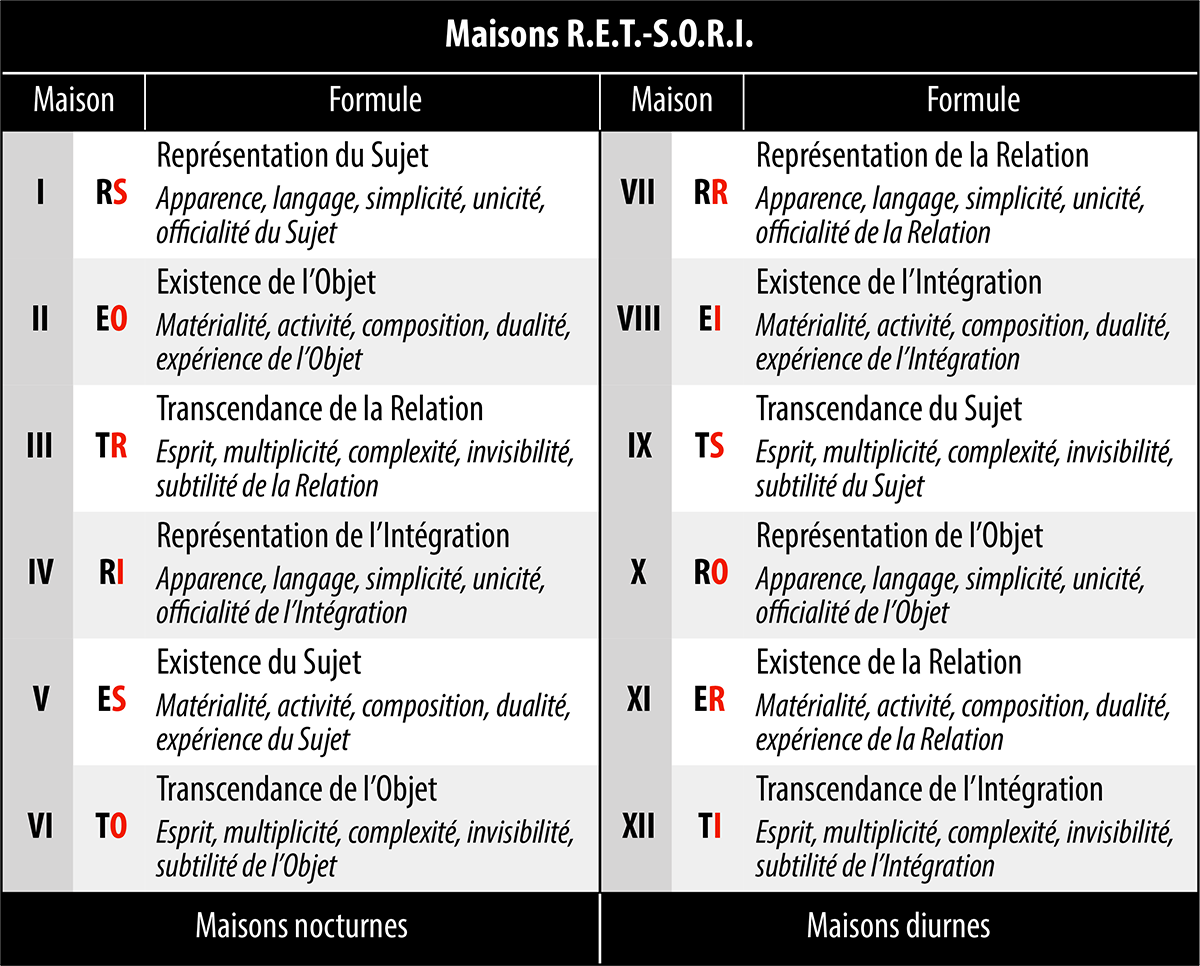
The observation is astonishingly true. By not considering the field of meanings of the Houses that from the perspective of a historical document, there are clearly the implications and projections of the mind working on levels and combinations of these levels. Whatever system of divisions of the local sphere the conditionalist school will adopt, the meanings are defined by the R.E.T. applied to its four repositories.
These correlations dispense with the need for analogism with the zodiacal Signs, the Sign — and each degree of Sign — being a globality of the levels and not a moment of strength or weakness as given by the moment of the diurnal movement. In other words, the arc of 1° (on average) contains, depending on the planet considered, several cycles of twenty-four hours. For the Sun and only for it, we pose 1° of arc for one revolution in one day.
This system of meanings combining the S.O.R.I. and the R.E.T. promotes style exercises. He extracts traditional meanings from their down-to-earth rehashing. Between “goods and money” of House II and “the Existence of the Object”, there is a whole world to fill with your thoughts and observations.
The rating grids used for the encryption of planetary powers are part of the applications insofar as they take into account value sectors rather than the meanings of these sectors. The principle of rating is rigorous but summary: it does not “note” not the presence of a star, it assigns it a classification rank. The method of three levels (weak, medium, strong) proposed by J. Lebreton for hourly sectors could be extended to aspects, but it can also be quantified if we want to adapt it to other quotations.
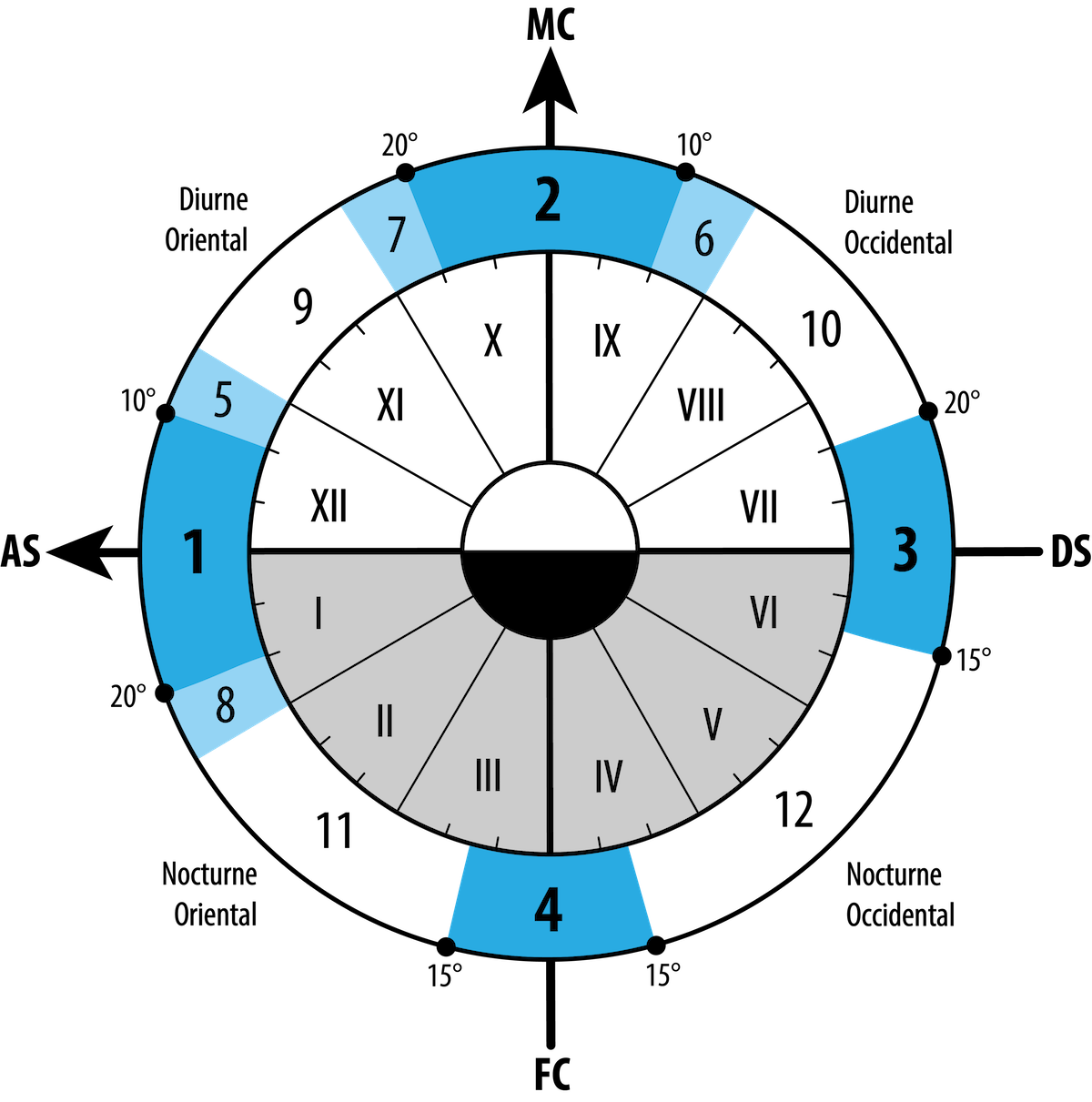
Fig. 10 : grille de hiérarchisation planétaire de notre logiciel Astrosoft depuis 2017. Ce système de cotation se fonde sur les angularités de la sphère locale (proximité des planètes aux angles AS-MC-DS-DC) qui déterminent des zones d’angularité (bleu fonçé) en lesquelles les planètes sont fortes, et des zones adjacentes (bleu clair) en lesquelles elles sont d’importance moyenne. En combinant le critère d’angularité avec celui des Aspects, on peut déterminer la hiérarchie planétaire d’un Thème.
The practical applications concerning the new definitions are not systematic. They are done gradually for the clusters, the characteristic distributions, and after exhaustion of the meanings given by the planets. The subset of angles I, X, VII, IV seems to have proven itself. The practical tests, for the other sectors, await a teamwork which would set out to examine collections of charts built according to various methods of house building.
Personal practice and group practice, biographical studies. The checks should focus primarily on forecasting: rating grids, house systems, meanings of sectors, planet-sector relationships, charts of azimuths and heights. The investigation program is a priority because of the certainties to be conquered to broaden the currently limited field of applications and convincing correlations.
Astro-psychology say “traditional” is not concerned with doctrinal homogeneity. Thus, all horoscopic factors are mostly interpreted on the basis of their projections in the plane of the ecliptic. But the election of this plan does not exclude the use of a house system that favors another (Placid house building for example). The conditionalists must ensure the homogeneity of the doctrine, justify the predominance of a reference plane or, on the contrary, specify the order, the number, the meanings of the different planes involved in the construction of a chart. The projection of the planetary positions in the plane of the horizon would make it possible to ascertain the role — possible — of the azimuths. The projection in the meridian plane leads to the chart of heights and in this respect, some tests have given positive results, at least for the highest planet and for those of zero height. These natural ways eliminate the need for fictional horoscope factors. By following them, the practitioner quickly realizes the fecundity of reality.
The photoperiodic zodiac favors time rather than space divided into Signs. The declination zodiac favors the plane of the celestial equator. For reasons to which I will return in analytical studies, it could be, finally, that the equatorial plane deserves to come in first position. It seems to have to simplify and clarify many problems…
On the side of the meanings of the sectors, the abstract formulas are to be taken up and explained by concrete illustrations. Our prospective will also have to standardize or mark out the interpretation of the planet in sector. The common reference to R.E.T. makes things easier and already makes it possible to understand certain affinities or non-affinities observed until now and vaguely justified by analogism. For example, affinity of ‘r’ planets (Sun, Jupiter, Uranus) with the angular sectors, notably with sectors I and X, strong among the strong.
The planets being defined by functions of rising, maintaining, depression of a level, the sectors theoretically delimit the selective domain of application of these functions. Here again, a rational language — even if it is not scientific — advantageously replaces symbolist indeterminacy. However, the deciphering of each formula, by mobilizing both logic and imagination, requires mental effort and a mastery of language contrary to the habits of ease adopted in the Symbolist schools.
The continuous improvement of the quotation grids is part of conditionalist foresight. It is time to say that this school not having the imperative to seduce the established scientific body, its methodology directly aims at the progress of the knowledge of astrology, and not those of a personal career subject to official methods. The statistical results are not rejected, they are placed in their context.
Always the same: the real, imagined, imaginable, measured or measurable, controlled or controllable, satisfying symbols and signals.
Explanation of the number, order of importance, nature and quality of the aspects as well as their functions, essentially refers to the chronaxie theory, laws governing nerve transmissions. These laws are not taken literally, only the principles have been retained: time, in the form of frequencies, reigns objectively in the neuropsychic subjectivity of man. Our “turnouts” — thus, the neurophysiological supports of our associations of ideas and patterns of behavior — depend on our chronaxies, constitution and subordination. I have dealt with these questions in the series on aspect theory, published in Astrologique (12). However, let me remind you of a few definitions:
“The neuron can be excited either directly or through a sensory organ or another neuron. It is directly sensitive to mechanical, chemical, electrical, thermal, osmotic excitations… Whatever the mode of excitation chosen, it must always have not only sufficient intensity, but also sufficient duration. There is a hyperbolic relationship (emphasis mine) between the minimum necessary magnitude of the intensity and the corresponding minimum duration. A very brief stimulus must therefore have an extremely high intensity, while a low-intensity stimulus must have a prolonged duration. If it is possible to reduce the duration of action of a stimulant to an infinitely short time, on condition of giving it an infinitely great intensity, there is on the other hand a minimum threshold of intensity or rheobase below which, whatever whatever the duration of the stimulus, no reaction is obtained. We often give the name of useful time to the minimum time necessary for the action of a stimulant for it to become effective. The chronaxie (Lapicque) is the useful time of the exciter whose intensity has a value twice the rheobase. For the nerve fibers of conscious sensitivity, in humans, excluding the painful fibers ensuring the innervation of the striated musculature, this useful time is extremely short and less than 1/1000 of a second. It is only for the unmyelinated nerve fibres, ensuring the innervation of the so-called autonomic effector organs, i.e. the smooth muscles and the glands, that the useful life of an exciter must be longer. It would be so, also, possibly for the fibers of the painful sensibility” (13).
We will see later what can be deduced from the differentiation between fibers sensitive to short durations and the others relating to “long durations”. Analogists will at least remember that long durations are painful.
A priori, the time scales are not comparable, but everything happens as if the short durations of the solar system were also subject to a higher reactivity.
Each neuron, according to its diameter, its constitution, has an appreciable field of excitability by the chronaxie which measures the useful time (duration) of an exciter whose basic efficiency intensity has been doubled, i.e. the minimum stimulation required to obtain a response. The useful time of the rheobase is not the same as that of the chronaxie, but it falls under the same hyperbolic function. In popular language and for the purpose of understanding, it would be better to speak of useful life (for the rheobase or the chronaxie), let us remember that it is, in any case, included in the definition of the chronaxie.
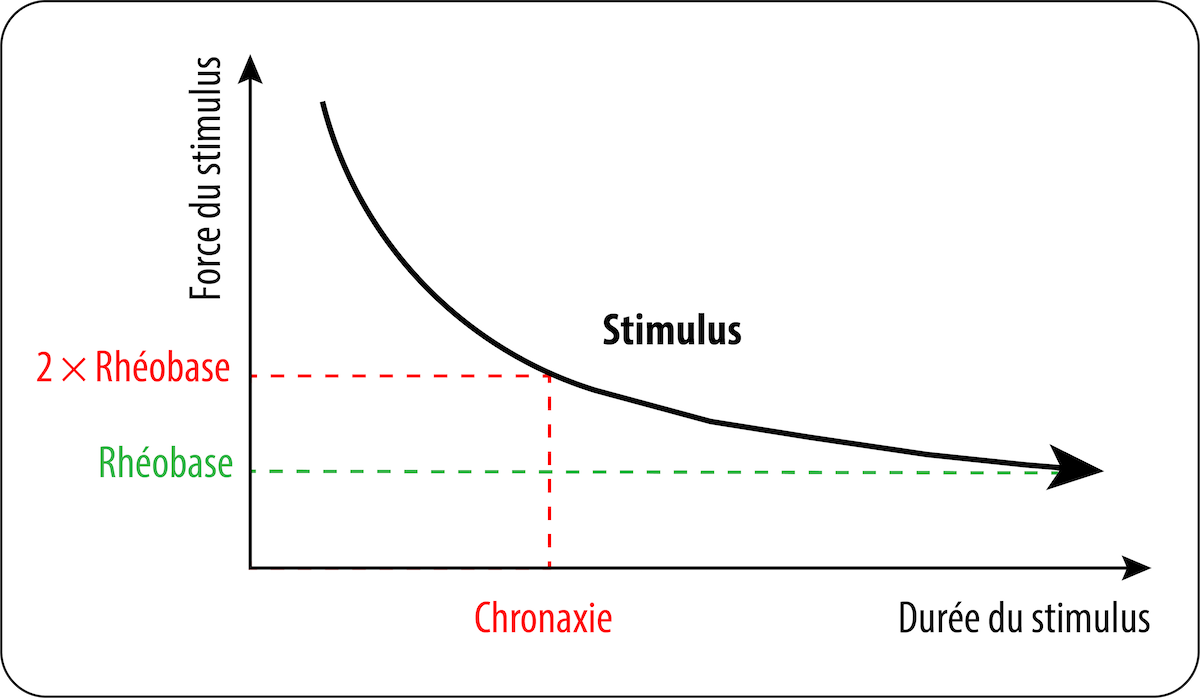
Fig. 1 : le modèle mathématique des chronaxies peut être utilisé pour comprendre les Aspects planétaires dans le ciel natal et lors des Transits.
The durations or chronaxies are involved in the rules of transmission between neurons and selection of nerve impulses. Always on very different scales, it is still about the action plan of the aspects: “…for transmission to take place between two neurons, they must have the same chronaxie or a similar chronaxie, a difference from single to double stopping synaptic transmission. We can thus understand on this basis what opens certain paths to impulse and closes others among all that is anatomically possible; one only has to suppose that the different neurons do not have the same chronaxie…” (13).
The ratio of simple to double (fraction 1/2) resurfaces. I talked about it about R.E.T., of the planetary organization, of the criterion for dividing the zodiac of the declinations into twelve Signs. It’s no joke when “in the current state of astro-reflexology”, I affirm that from this report, it is possible to reconstruct the main lines of conditionalist astrology. This ratio of 1/2 is part of the organizing structures common to the subjective and the objective, facilitating or conditioning their relations of homogeneity, that is to say the means by which there is no longer any difference between the top and the the bottom, the microcosm and the macrocosm, Man and the environment, the structure allowing the same reading. The 1/2 ratio is selective: it makes certain transmissions possible and eliminates others. The possibilities concern the neurons whose chronaxies call, by constitution, a participation, a convergence, which is the case for the transmissions requiring the harmonious execution of a movement: the contraction of a muscle must be assisted by the bending (relaxation) of another, simultaneously, the “agonists” and “antagonists” thus having to cooperate, like a hill start where, in order not to stall, it is necessary to adjust the brake and the acceleration, press and release at the same time.
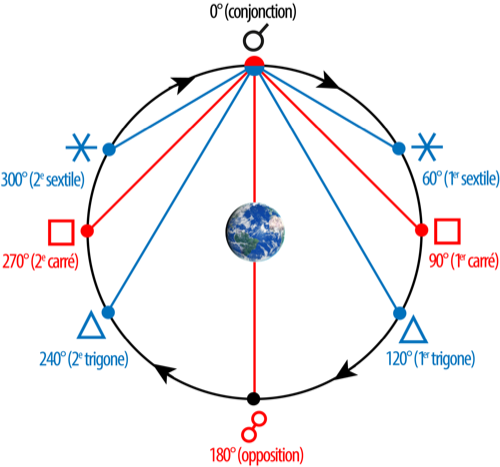
Fig. 3 : représentation des 5 Aspects majeurs. Les Aspects mineurs comme le semi-carré et le semi-sextile peuvent être négligés, sauf quand ils réunissent des planètes dominantes. Les Aspects sont les phases dynamiques d’un cycle croissant puis décroissant, et non des angles figés dans un espace statique.
This problem of “agonists and antagonists” has been translated by astro-psychology in terms of conflicting tendencies. These terms are transposable: submission-domination, flexion-extension, tension-relaxation. It makes it possible to understand the dissonant aspects according to the nature of the planets in question: which can give way to the other?
But the chronaxies are not rigid. They vary, in the name of adaptation, in order to favor or facilitate transmissions “of circumstance”. The nerve centers (the higher commands) modify the chronaxies of constitution: “…the nervous chronaxies are in perpetual fluctuation, under the influence of multiple central or peripheral factors which can act on subordination (posture, fatigue, pain, distraction, attention)… Thus, under the influence of the centers, the chronaxies oscillate between two extreme values exactly like the chronaxies of the visceral muscles after the action of excitatory and depressant chemical mediators” (14).
Which means, in the astrological transposition, that the aspects are interpreted according to the transits, the situation experienced and the objectives that we set for ourselves. Astro-conditionalism is far from having exhausted its openness to chronaxies. The fruitfulness of his first approach at least puts an end to false spatial analogies by emphasizing the primacy of the temporal dimension.
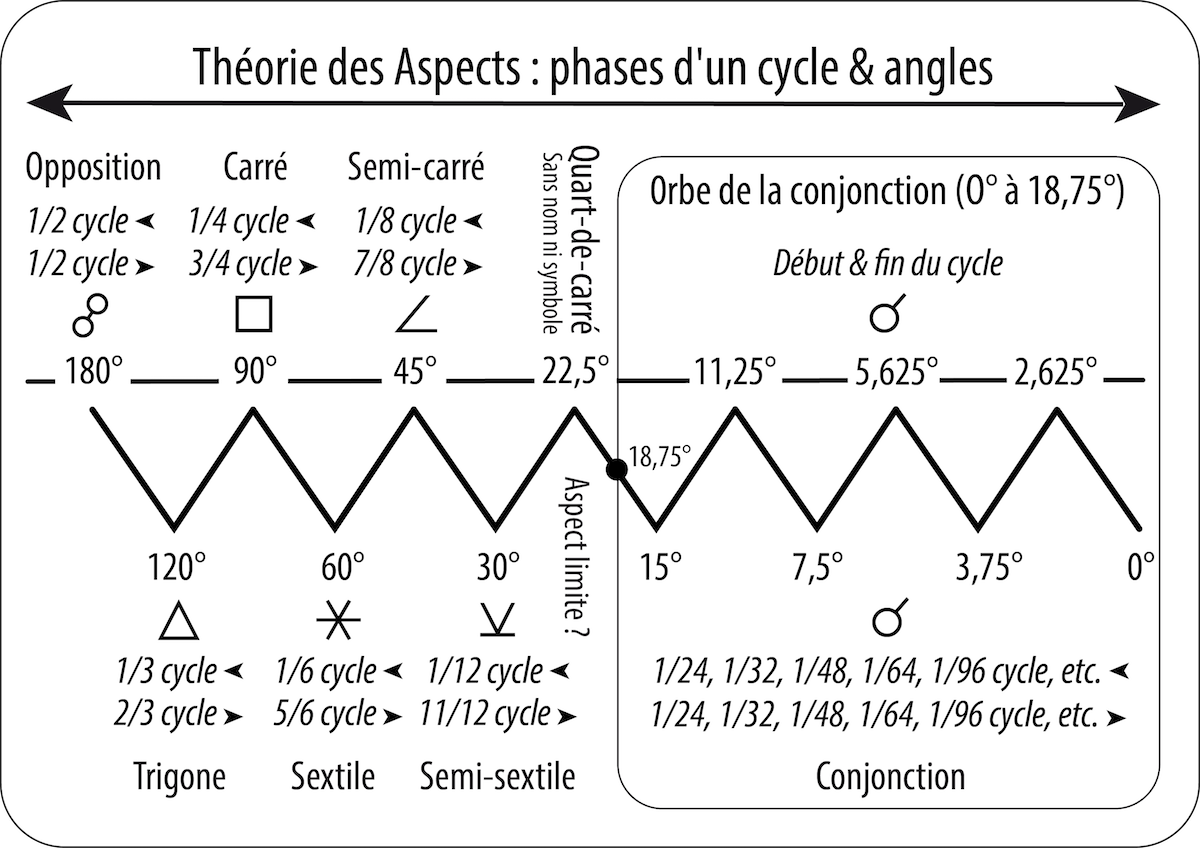
Fig. 2 : de la théorie mathématique des Aspects, il découle logiquement que l’orbe de la conjonction contient une multitude d’harmoniques consonants et dissonants. La conjonction est donc à la fois consonante ou dissonante, selon les Aspects consonants ou dissonants qu’elle reçoit. Cette même théorie permet aussi de comprendre qu’on peut élargir l’orbe de la conjonction jusqu’à 18°.
The model of chronaxies and the 1/2 ratio (progression of so-called dissonant aspects) make it possible to interpret an aspect in the absolute by considering only the nature of the planets put in relation and in the relative, by evaluating the chances of coordination and of subordination according to the program to be fulfilled, the goal to be reached, the state of tension or relaxation. The R.E.T. guides the interpreter by giving the diagram of the functions confronted, the levels that they activate or inhibit. Definitions in short, medium and long memories are useful for assessing possible, impossible or difficult modes of coordination. Each configuration has its problem, the interpretation consists in finding the best solution(s): that is to say the “program” capable of coordinating naturally antagonistic functions (15).
The practical applications of the aspects largely relate to the interpretation of the transits, these actualizing natal configurations and issues involved in prevailing planetary relationships. In this perspective, the transits mark the moments of sensitization or desensitization, the moments when the problems call for decisions of engagement or disengagement. It is futile to seek these decisions in the sky, but the possible solutions become narrower over time and, depending on the nature of the problem posed to poor means, the problem may be insoluble or of inescapable outcome.
It can be seen from the foregoing that the unconditional statistics teach us nothing. It will be up to foresight to establish our statistical control protocols with more subtlety than fatalists, symbolists or scientists. In the meantime, control is exercised through personal or collective practice. To be convincing, it must be intensive, bearing, for example, on the successive responses given to a clearly singular configuration in a chart. The problem of the aspect is then accompanied by its history.
It is necessary, first of all, to deepen the model of the chronaxies and to find the theoretical justification of the passage from the micro-durations characterizing the nervous excitability to the macro-durations given by the planetary cycles. The study of memorization is directly concerned. A priori, it may be thought that the persistence and repetition of configurations encourage, over time, the formation of temporal patterns or rhythmic structures that facilitate certain adaptive behaviors rather than others. The theoretical work that remains to be done is enormous. It imperatively requires a serious knowledge of neurophysiology and psycho-physiology.
Another point of the prospective will have to relate to the specifically conditionalist methods of control, capable consequently of testing the interactions between horoscopic factors and non-horoscopic factors (family, social, biological).
The issue of orbs or efficiency margins for transits and aspects also arises. The reference to the neurophysiological and to the law of “all or nothing” (a neuron responds or does not respond), already makes it possible to understand that the orb is a range and not a peak: the effect is not proportional to the precision of the aspect, the aspect exists or does not does not exist and practice shows that a 10° conjunction is just as effective as a conjunction without an orb. Many of “practitioners” Astro-symbolists will argue otherwise. We can be sure that an author who supports — in the name of what? — that an orb of 8° for conjunction and opposition is too wide, has neither a coherent theory to its credit, nor a good disposition for psychological observation.
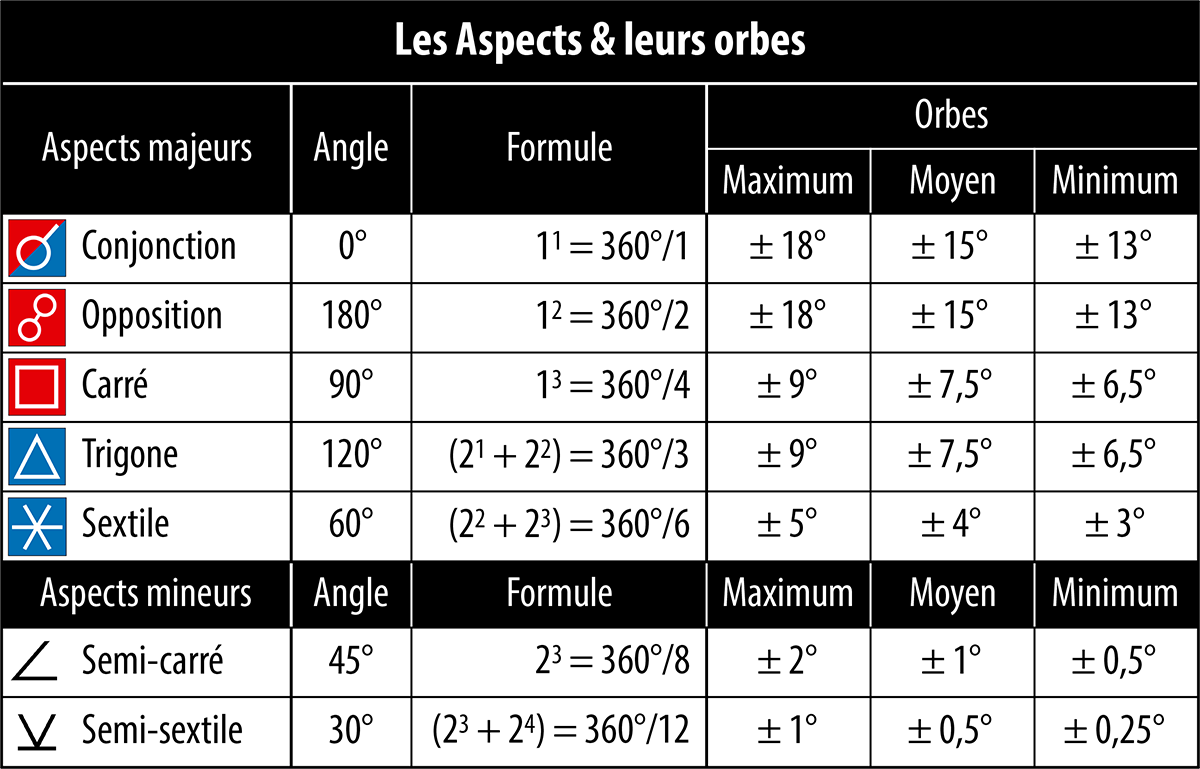
Tableau 1 : l’efficacité d’un Aspect n’est pas proportionnelle à son exactitude. Elle s’effectue à l’intérieur d’un orbe avant et après l’Aspect exact. L’étendue (minimum, moyenne, maximum) des orbes découle de la théorie mathématique des Aspects. L’observation montre que les planètes rapides admettent des orbes plus larges que les lentes. Il en va de même pour les planètes angulaires, qu’elles soient rapides ou lentes.
The argument that the enlargement of the orbs multiplies the number of aspects is fallacious. For the conditionalists, the astrometric and neurophysiological reference (ratio 1/2) shows that the aspects of conjunction and opposition could authorize, by their importance, an interpretation excluding the other aspects. It is hard to go wrong by expanding the orbs of the major celestial phenomena (angularities, conjunctions, oppositions) and neglecting the minor ones. It is still by this very selective way that conditionalist astrology progresses while the other schools discuss the 2 or 3° to add or subtract from the aspects.
It remains that the 1/2 ratio which was used to explain the aspects can be extended to the extent of the orbs under conditions to be specified. In principle the orbs must depend on the ratio of the planetary durations concerned by an aspect or other complementary factors. The formula is not found. Again, it will probably put time (duration of a configuration) to work, rather than space.
Technically, any in-depth interpretation requires prior classification and prioritization horoscope factors using an ordinal rating system. All of the configurations are broken down into subsets of which the performer seeks the articulations, the points of junction or disjunction. The zodiac signs are also classified, the reflexological formulas facilitating syntheses and groupings.
With these operations, the interpreter is not stopped by an absence or an overabundance of angularities. The ratings and the resulting hierarchy allow it to process, depending on the deviations obtained, two, three or four planets at the top of the list. Depending on the number of factors he wants to integrate, he can consider all the planets or set an analysis threshold.
The model of R.E.T. makes it possible to locate the privileged functions, to understand them by the deficiencies which they entail. The interpreter chooses, at his discretion, detailed analysis or the synthetic reduction which generally amounts to summarizing the problem or problems that the sky can bring about in the unfolding of destiny and the possible solutions within the scope of the means of adaptation indicated by the chart, supplemented, amplified or reduced by the family and socio-cultural conditioning.
A key configuration is not necessarily dominant, and the major problem is not necessarily in the function of a single planet, even less in the typological signature. No recipe is possible. For each chart, the interpreter must carry out a creative and original work that leaves consultation far behind the assembly line where the master delivers to his patients the robot portraits of his works. And even in a theoretical work like that of the 210 portraits given by the combinations of the planets taken 4 by 4, it is necessary to get out of the typologies and have the formulas of the R.E.T. in memory to imagine living personalities instead of describing bookish entities.
To respond correctly — or as best as possible — to a oral consultation, the conditionalist must first understand the sky that is submitted to him and the exact relationship that the consultant has established with his sky (the lived chart). The problem that sometimes emerges from a consultation is not necessarily the one for which the astrologer is consulted. This is why conditionalist astrology believes that several sessions, more or less spaced out, are better than the statement, in one or two hours, of “natal trends” and “two to five year forecast” which will not change the data and will certainly not allow the consultant to make sound decisions.
All the results of conditionalist research are at work in conditionalist consultation, and it is these that have made it possible to develop a theory of consultation as well. It comes down to the management of time included in the couple chronology-simultaneity. From the synthesis of the present, apparent and virtual factors of a situation, it is necessary to identify the chronology which can result from it, then to propose the decisions which can favor one development or another, more advantageous or less unsatisfactory. Possible solutions are discussed with the consultant. They are not dictated to him, the only remedies worth trying are those whose necessity we have understood, the good resonance with his own nature.
Thus, the conditionalist consultation should normally result in “another life plan” modifying even slightly the relationship with oneself as with others, in accordance with the applications of homogeneity (see R.E.T. and S.O.R.I.). Theoretical explanations are not forbidden — when they are possible — to open up a consciousness to its power over the future from a better possession of the present, of the whole present.
This present is not exclusively in the horoscope “subject reflection”. It’s also the facts policies, economic, social of our contemporary world. The homogeneity that everyone aspires to find goes far beyond strictly egocentric solutions. It can only be realized in a world that is itself homogeneous, in a context acting at least in this perspective. It is therefore not out of utopia or intellectual Marxism that conditionalist astrology is interested in the sciences, the arts, philosophies or politics. And it is not, either, by constitutional aggressiveness that it opposes the scientistic ghettos or symbolico-magists.
Neither collectivist nor individualist, our ethic is perhaps that of a Mars homogeneous: a Mars which places the dynamics of the living and the real at the center of things, which does not allow itself to be divided either by the blindness of the right eye, nor by the blindness of the left eye. The sharpness of the gaze passes through both eyes.
In fact, astro-psychology comes from an inventory of supplies and frills for our consumer society, hence his brilliant commercial career and the assured media support. Beyond its profitability, what thought can it claim exactly? Nothing is consistent there. It is necessary to cover with a great discourse on the unspeakable an indescribable jumble of ideas, of unbridled analogisms, incapable of grasping in depth the astrological reality.
The empiricists are content to practice without any particular doctrine, sometimes adding figures and tarot cards to the use of the horoscope. Discreet, they wait for the future without being hostile to innovations justified by better results for their consultants.
The spiritualist astrologers worthy of the name have a practice and an approach which, in the end, do without horoscopes by elevating astrology far too much above the planets.
There are symbolists who strive to build a coherent doctrine from traditional keys purged of their concrete roots. For these too, the physical dimension, the real, is of little importance.
The conditionalist positions are too different for easy exchanges with these schools. Nevertheless, as long as the attitude is loyal on both sides, a courteous coexistence is possible. The conditionalists have also made known in their writings and teaching, the works of Rudhyar, Ruperti, Santagostini.
Logically, relations could only deteriorate with the best established, materially and intellectually, in the advantages of magico-symbolism. For conditionalists striving to clarify, explain, liberate from alienating dominations, it is difficult to understand the imprecations of a irascible marabout sweating blood and water at the slightest objective resistance. But, for a subjugated medium, it seems quite normal to punish the “luciferians” by silence or slander. In this spirit of evangelism, there is no shame in insulting the memory of the dead (J. Kepler) and remove from the history of astrology anything that risks awakening the path of reality.
The balance sheet astro-statistics is a good godsend to wash off peccadilloes. In his name, we can talk about something completely different, continue to muddle and mend while declaring to the customs of the Universities: “there are Gauquelin’s statistics”, even if Gauquelin was out of breath to say that his works invalidated the symbolist foundations, confirming on the contrary the conditionalist option for the explanatory natural. Should we be surprised at the double silence towards us from the magists and scientists? Their balance sheets support each other.
Ours has given astrology back its independence and grandeur.
▶ (1) L’astrologie, Paul Couderc, coll. What do I know? (old edition), PUF.
▶ (2) Kepler astronome astrologue, Gérard Simon, Gallimard 1979, chap. III on astral conditioning and the mystery of endings.
▶ (3) Hippocrate, Robert Joly, coll. Ideas, Gallimard.
▶ (4) The hare, it is of size, was lifted by Max Lejbowicz.
▶ (5) Of course, with regard to symbolist astro-psychology and its wild applications in psychoanalysis, when conditionalists discuss, their incomprehensible exchanges denote homosexual attraction or a father-son relationship.
▶ (6) View Nombres et formes du cosmos, J.-P. Nicola, Ed. Traditional.
▶ (7) For a modern astrology, J.-P. Nicola, Seuil 1977.
▶ (8) title of a book by Joël de Rosnay, Le Macroscope, Seuil.
▶ (9) View La nouvelle grille, H. Laborit, Laffont.
▶ (10) Cahiers conditionalistes No. 1, Essai sur les puissances planétaires.
▶ (11) Introduction à l’astrologie conditionaliste.
▶ (12) Astrologique No.?
▶ (13) Éléments de physiologie psychologique, Pierre Rijlant, Masson.
▶ (14) L’influx nerveux et la psychologie, Dr Paul Chauchard, PUF.
▶ (15) A book on aspects is in preparation. Conditionalist enthusiasts will find the R.E.T. that underpin the interpretation. When the aspects were first published, the theoretical demonstration had been eliminated for eternally commercial reasons. No censorship afflicting the next publication, it will no longer be possible to attribute to astro-psychology what amounts to conditionalism.
Article published in issue No. 1 of the Cahiers conditionalistes (April 1980).
▶ General theories
▶ Réflexions conditionalistes

Les significations planétaires
par
620 pages. Illustrations en couleur.
La décision de ne traiter dans ce livre que des significations planétaires ne repose pas sur une sous-estimation du rôle des Signes du zodiaque et des Maisons. Le traditionnel trio Planètes-Zodiaque-Maisons est en effet l’expression d’une structure qui classe ces trois plans selon leur ordre de préséance et dans ce triptyque hiérarchisé, les Planètes occupent le premier rang.
La première partie de ce livre rassemble donc, sous une forme abondamment illustrée de schémas pédagogiques et tableaux explicatifs, une édition originale revue, augmentée et actualisée des textes consacrés aux significations planétaires telles qu’elles ont été définies par l’astrologie conditionaliste et une présentation détaillée des méthodes de hiérarchisation planétaire et d’interprétation accompagnées de nombreux exemples concrets illustrés par des Thèmes de célébrités.
La deuxième partie est consacrée, d’une part à une présentation critique des fondements traditionnels des significations planétaires, d’autre part à une présentation des rapports entre signaux et symboles, astrologie et psychologie. Enfin, la troisième partie présente brièvement les racines astrométriques des significations planétaires… et propose une voie de sortie de l’astrologie pour accéder à une plus vaste dimension noologique et spirituelle qui la prolonge et la contient.
Téléchargez-le dès maintenant dans notre boutique

Pluton planète naine : une erreur géante
par
117 pages. Illustrations en couleur.
Pluton ne fait plus partie des planètes majeures de notre système solaire : telle est la décision prise par une infime minorité d’astronomes lors de l’Assemblée Générale de l’Union Astronomique Internationale qui s’est tenue à Prague en août 2006. Elle est reléguée au rang de “planète naine”, au même titre que les nombreux astres découverts au-delà de son orbite.
Ce livre récapitule et analyse en détail le pourquoi et le comment de cette incroyable et irrationnelle décision contestée par de très nombreux astronomes de premier plan. Quelles sont les effets de cette “nanification” de Pluton sur son statut astrologique ? Faut-il remettre en question son influence et ses significations astro-psychologiques qui semblaient avérées depuis sa découverte en 1930 ? Les “plutoniens” ont-ils cessé d’exister depuis cette décision charlatanesque ? Ce livre pose également le problème des astres transplutoniens nouvellement découverts. Quel statut astrologique et quelles influences et significations précises leur accorder ?
Enfin, cet ouvrage propose une vision unitaire du système solaire qui démontre, chiffes et arguments rationnels à l’appui, que Pluton en est toujours un élément essentiel, ce qui est loin d’être le cas pour les autres astres au-delà de son orbite. Après avoir lu ce livre, vous saurez quoi répondre à ceux qui pensent avoir trouvé, avec l’exclusion de Pluton du cortège planétaire traditionnel, un nouvel argument contre l’astrologie !
Téléchargez-le dès maintenant dans notre boutique